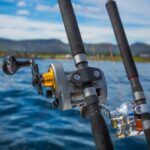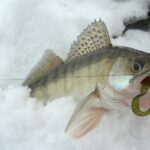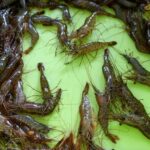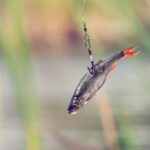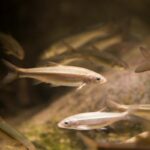Fishing is an entertaining sport that requires not only high levels of skill but also a good understanding of where and when to use the right gear.
One piece of gear you might not use enough is plastic worms.

If you consider yourself to be an experienced angler, the chances are you already know just how effective and efficient live worms can be as bait but did you know that plastic worms, when used correctly can be effective too?
While they might not be up there with the fanciest, latest tackle trends, you should never overlook plastic worms’ effectiveness, especially when catching bass.
In fact, using plastic worms may just be the most effective bass fishing technique ever created. With all of that in mind, we want to help you use plastic worms correctly and successfully.
To do that, we’ve put together this article that shows you everything you need to know about plastic worm fishing.
We’ve even included the best tips to get you started.
Let’s get started, shall we!
What Does Fishing With Plastic Worms Entail?
Before we look at anything else, let’s give you a rundown of what fishing with plastic worms entails. Plastic worm fishing consists of using plastic worms, also known as trout worms to attract fish.
Plastic worms are a type of fishing lure designed to look and behave like earthworms.
They come in a wide range of different colors and sizes and tend to be made out of a variety of different synthetic polymers.
Some plastic worms are even scented to help closely simulate live bait.
Versatile in the way they can be rigged, most plastic worms are used with small fishing hooks and a split shot weight. This helps keep the lure deeper in the water, hence their suiting to bass fishing.
The desired fishing equipment to use with plastic worms is a 7-foot rod and an 8 to 10-pound test fishing line. The fishing strategy commonly used with plastic worms is to use a Texas Rig and bounce the lures off the bottom.
Do Plastic Worms Actually Work?
Strangely, there are a lot of anglers that have great suspicions when it comes to using plastic worms when in reality there is no valid reason not to use them.
A wide variety of artificial lures, not just plastic worms, are regularly used as baits to catch all kinds of different species of fish.
Artificial plastic worms, in a lot of cases, can actually be the most effective type of ‘fake’ lure to use.
They are designed to “wiggle” in the water just like a live worm would, so you can rest assured that their movement will attract fish.
Unlike live baits, plastic worms have to be moved by the angler. As far as artificial baits go though, moving plastic worms is fairly easy.
Plastic worms also have some advantages over live bait. They come in a range of different sizes so they don’t need to be cut. You also won’t have any struggle hooking them.
The variety of colors they come in also makes them much more versatile than live worms in regard to finding the perfect bait for the location you’re in and the fish you’re looking for.
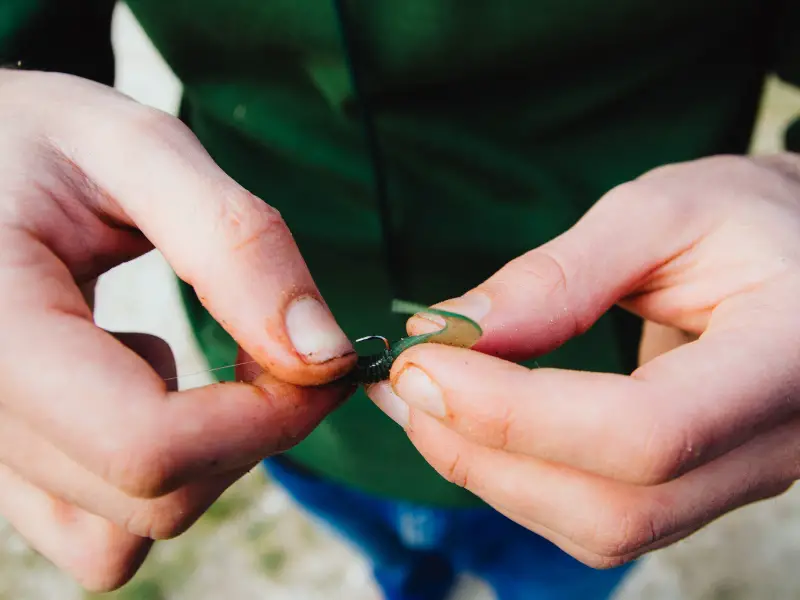
How To Successfully Fish With Plastic Worms?
Fishing using plastic worms isn’t too different from fishing with live ones.
It is also quite simple, which makes it a good choice for beginners looking for a more basic way of fishing.
However, while it may be an easier way of fishing, there are still a number of important things to keep in mind if you want to do it successfully.
To give you a better chance of being successful, we’ve detailed the most important things you need to do and what you shouldn’t do below.
Let’s take a look!
Use Light Gear
If you’re planning on fishing with plastic worms it’s important to use lighter gear.
This includes a hook of reasonable size and a corresponding fishing line.
Using this lighter gear will give you more control over the lure and make it much easier to wiggle the worm as you cast it into deeper waters.
Don’t Overcomplicate Things
Just like you would when fishing with live bait, make sure you don’t overcomplicate things.
The best way to do things is to keep everything to a minimum and use specific gear based on the type of fish you’re trying to catch.
Like using live bait, you may wish to use floats and choose a straight shank hook.
This will keep things simple and make the plastic worm move naturally.
Choose The Right Hook
On the topic of hooks, it’s important to choose the right one when using plastic worms to fish.Using the right hook will ensure perfection and prevent your plastic worms from sliding down the hook eye.
Avoiding larger hooks is a good place to start as they tend to result in fewer bites.
Avoid Reeling And Dragging
When you start moving your lure, try not to reel it in or drag it too perfectly or at a high speed.
This will lead to unnatural movement and fewer bites. Instead, you should try hopping the lure as this will look more natural.
A lot of anglers also let the lure sink naturally. If there is no interest in the bait, simply repeat the process. You might even decide to slow the process down in areas with high levels of vegetation.
Of course, like any type of fishing, you will require patience.
Avoid Large Movement
In order to attract fish to your plastic worms, you should do everything you can to avoid any large movements with the tip of your rod.
To avoid this, simply twitch the rod gently to move the bait.
You’ll find that a lot of fish, particularly bass, strike plastic worms the second they see them naturally sinking.
Have A Variety Of Plastic Worms To Choose From
One of the best things you can do when it comes to guaranteeing success with plastic worms is ensure you have a range of different types of plastic worms to choose from.
Keep multiple plastic worms of different sizes and colors in your tackle box.
This gives you more freedom to change to a different bait when conditions change, when you decide to fish for a different species, and when your move location.
The same can also be said about hooks. The same hook doesn’t suit every type of fishing.
Change things up and try new hooks to see what works best. This is especially important when fishing somewhere new.
Use A Fluorocarbon Line
We recommend using a fluorocarbon line when fishing with plastic worms.
The reason for this is pretty simple. Fluorocarbon lines are a lot less visible to fish than other types of lines.
This type of line is also not as stretchy. This gives a direct and straight transfer of energy when using larger hooksets.
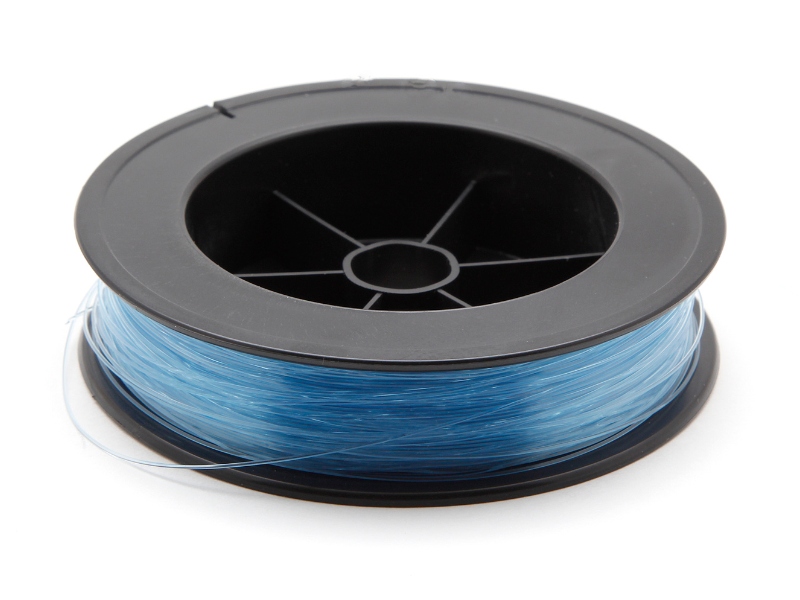
What Species Of Fish Can You Catch Using Plastic Worms?
While getting the above factors right will help you catch more fish, you still need to know which type of fish you’re going after if you’re going to be successful.
The tips we’ve mentioned will make it easier for you, but how you set up your rig, and what equipment you use will depend on the type of fish you plan on catching with your plastic worms.
You can only plan to catch a certain species when you know what fish you can catch with plastic worms so let us show you!
There are a number of different species of fish you can catch with plastic worms but the most popular is bass.
Popular with beginners and more experienced anglers, bass are relatively easy to catch with plastic worms. We’ll show you how to catch them further down in this article.
Other popular species of fish to catch with plastic worms include sunfish and bluegill.
Both of these species are extremely attracted to plastic worms.
There are anglers that also use plastic worms to fish for trout too. Smaller plastic worms are normally used for this.
Curly-tailed plastic worms can be used to catch walleye and crappies.
What Fish Can’t You Catch With Plastic Worms?
It is worth noting that not every fish caught with live worms can be caught with plastic ones.
While it is technically possible, fish like catfish that love live worms won’t bite plastic worms.
This is mostly down to the plastic worms’ scent, or lack of.
Artificial worms don’t have the strong smell real ones do.
Unfortunately, this smell is important when it comes to catching catfish. Without it, the chances of catching one are massively reduced.
There are plastic worms you can buy that have a scent but none are as good as the real thing.
Catching Bass With Plastic Worms
Bass absolutely loves plastic worms, so much so, that they are probably the best type of bait to use when trying to catch one.
To bass, plastic worms look and feel just like one of its natural food sources, leading the bass to suck and hold onto them for a while. This gives you enough time to make your move and hook the bass.
Chances of the bass striking your lure are further increased with scented plastic worms.
To successfully catch bass using a plastic worm, you should first select the best rig setup. Most anglers go for an effective Texas rig but there are some that won’t even use a weight.
The Texas rig is a great choice because it is simple and can be used with any type of plastic worm. You should then ensure your lure is positioned towards the bottom and that you have tension in your line.
Bass will suck your line so if it’s too loose you won’t notice. We recommend letting the lure sink naturally. Alternatively, hopping the lure also works.
In clear water, you should use a smaller lure (roughly 3 inches) as this won’t scare the fish and will come across as more natural.
In darker, murky waters, it’s important to use a lure that is more visible.
Maximize success by also taking the time of year, the type of plastic worm, and the hook into account. In winter, bass will be more suspicious of larger lures. In dark water, curly tail worms are better.
Finally, you can’t go wrong with a straight shank hook.
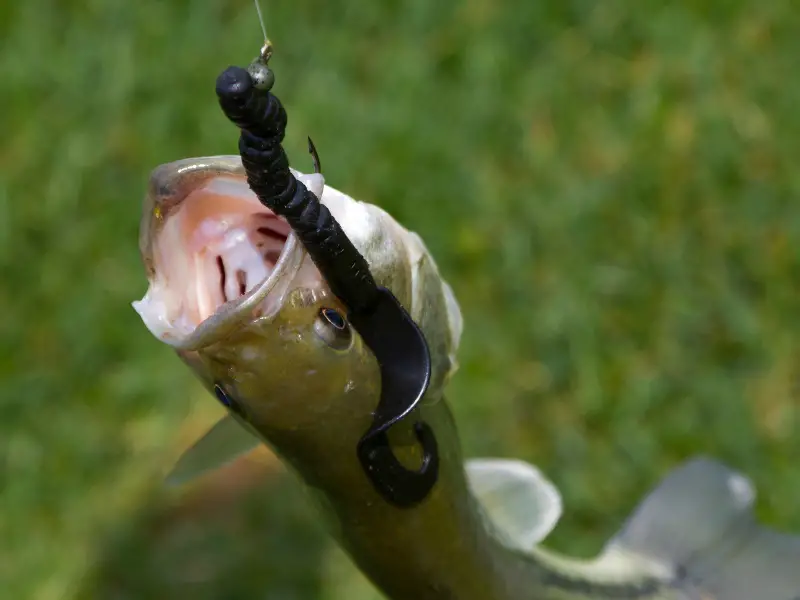
What Types Of Plastic Worms Are Best For Catching Fish?
Now we’ve covered all the bases for bass fishing using plastic worms, let’s take a look at what types of plastic worms we can use to catch other species of fish.
Typically, there are two different types of plastic worms used to catch fish. These are straight tails and curly tails.
Straight Tail
Out of the two options, the straight tail is the simplest choice. Available in many different shapes, sizes, and colors, this type of lure is highly effective.
The different types of straight tail lures available on the market include finesse-worms, trick-worms, and stick bait-worms.
Curly Tail
The second type of plastic worm available is the curly tail lure. Curly tail plastic worms are also available in a wide range of colors and sizes.
They tend to produce more vibrations and wiggle more than straight tail lures, making them the better option for fishing in darker waters. Fish will sense the movement of this lure before they see it.
Types of curly tail plastic worms include U-tail and ribbon-worm.
Choosing The Right Color And Size
To use plastic worms effectively, it is important to understand when it’s best to use certain sizes and colors. Colors should be picked based on the color of water you find yourself fishing in.
In clear waters, it is better to use plastic worms that look more natural and real. Therefore, you should choose a plastic worm that is green or brown in color. The worm shouldn’t be too bright either.
In darker, murky waters, you should consider experimenting with colors a bit more.
Brighter, multi-colored lures tend to be more effective because the fish has a better chance of spotting them. In terms of plastic worm size, you should use plastic worms that suit the type of fish you plan on catching.
The only time you wouldn’t do this is when you use smaller lures in clear water.
Aside from that, you should always use bait specific to your target. Generally speaking, the larger the plastic worm, the larger your catch. However, there is a catch!
Smaller baits are better at attracting larger fish, but larger baits will almost never catch smaller fish. If you don’t experience any action, that could be your sign to downsize.
We also recommend using smaller lures in winter and larger ones in summer.
There’s No Right Or Wrong
Above all else, it is important to remember that when it comes to plastic worms, there’s no right or wrong answer.
Every type and model or plastic worm is perfect for certain conditions, it’s simply a case of trial and error, and experimentation until you find the solution that suits you.
With that in mind, always have plenty of plastic worms on you.
In Conclusion
Fishing with plastic worms offers beginners and experienced anglers an effective way to catch a wide range of fish.
Hugely popular with bass fishing, when the best size, type, and color of plastic worm is chosen, fishing can be highly productive. Keeping a small collection in your tackle box can prove beneficial no matter where you find yourself fishing.
In this article, we’ve told you everything you need to know about fishing with plastic worms.
You should now know what plastic worms are, what to expect, what types of plastic worms are best, how to be successful, and what to avoid.
All that’s left to do now, is start your plastic worm collection and see how they impact your fishing!
- Do You Need An Indicator For Nymph Fishing? - November 16, 2023
- Fishing Safety Tips For Families - September 25, 2023
- What Is The Best Time To Night Fish At A Lake? - September 18, 2023




